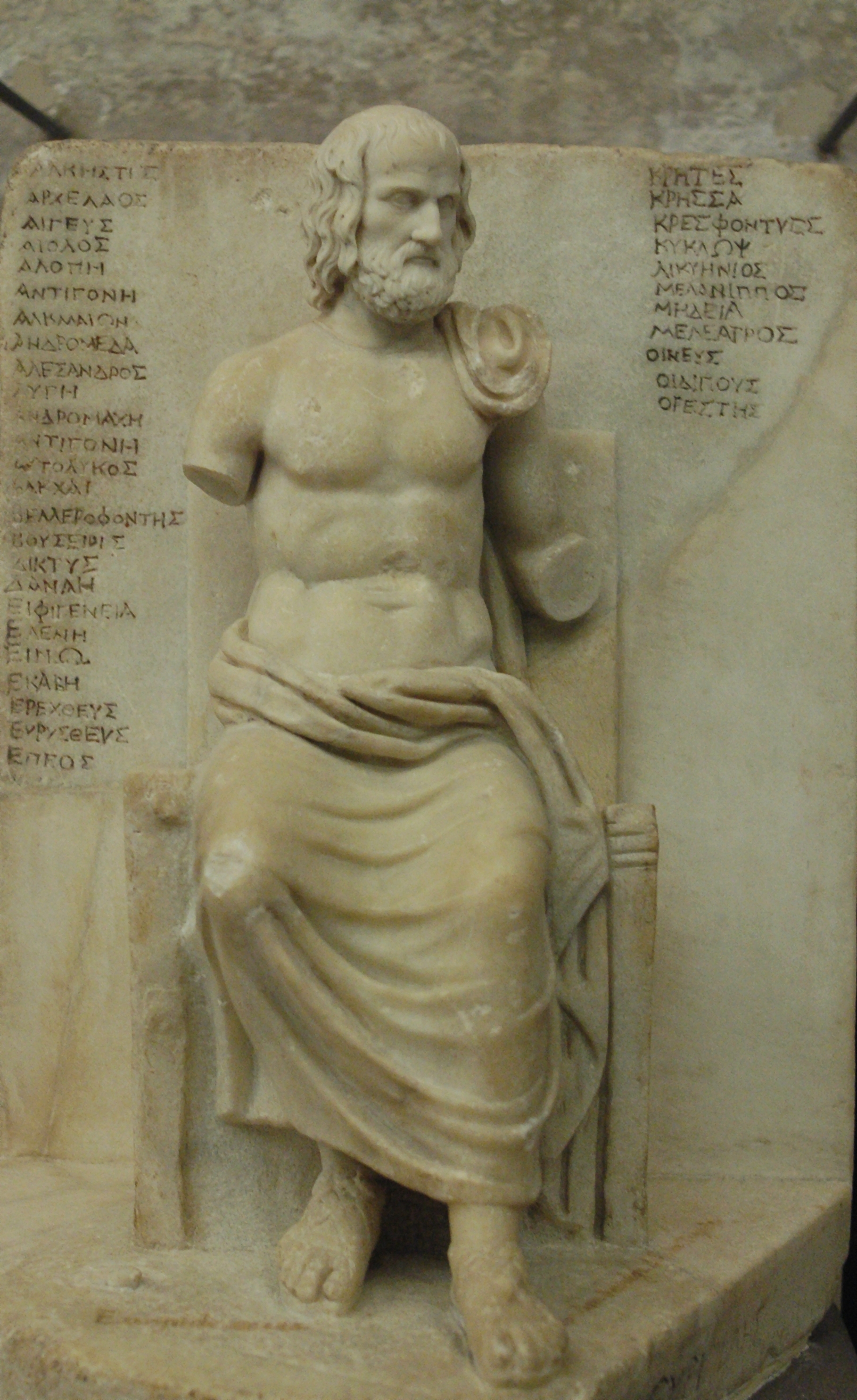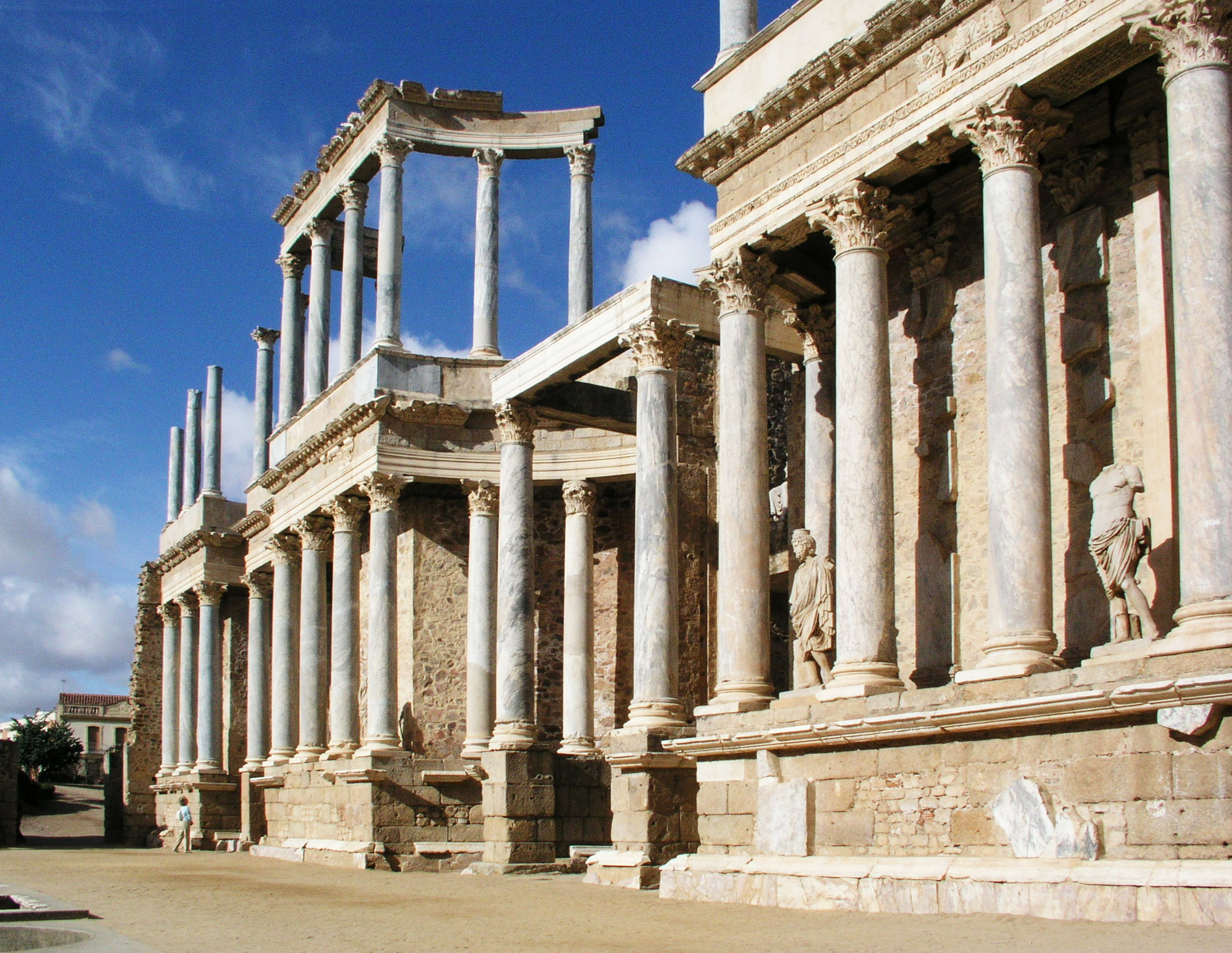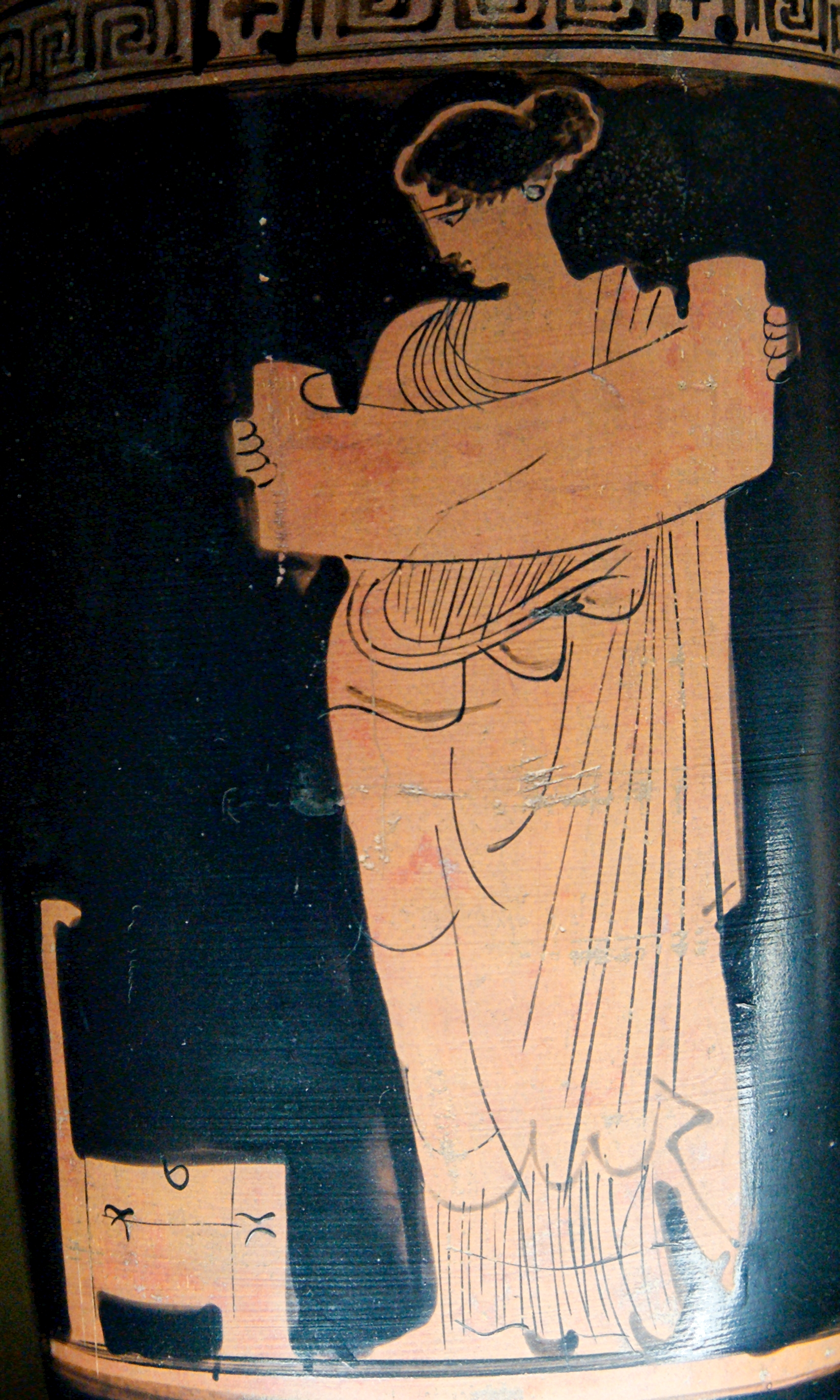|
Ekkyklema
An ''ekkyklêma'' or ''eccyclema'' (; ; "roll-out machine") was a wheeled platform rolled out through a '' skênê'' in ancient Greek theatre. It was used to bring interior scenes out into the sight of the audience. Some ancient sources suggest that it may have been revolved or turned. It is primarily used in tragedies for revealing dead bodies, such as Hippolytus' dying body in the final scene of Euripides' play of the same name, or the corpse of Eurydice draped over the household altar in Sophocles' '' Antigone''. Other uses include the revelation in Sophocles' '' Ajax'' of Ajax surrounded by the sheep he killed whilst under the delusion that they were Greeks.Rehm (1992, 69). The ''ekkyklêma'' is also used in comedy to parody the tragic effect. An example of this is in Aristophanes Aristophanes (; ; ) was an Ancient Greece, Ancient Greek Ancient Greek comedy, comic playwright from Classical Athens, Athens. He wrote in total forty plays, of which eleven survive virtually ... [...More Info...] [...Related Items...] OR: [Wikipedia] [Google] [Baidu] |
Euripides
Euripides () was a Greek tragedy, tragedian of classical Athens. Along with Aeschylus and Sophocles, he is one of the three ancient Greek tragedians for whom any plays have survived in full. Some ancient scholars attributed ninety-five plays to him, but the ''Suda'' says it was ninety-two at most. Of these, eighteen or nineteen have survived more or less complete (''Rhesus (play), Rhesus'' is suspect). There are many fragments (some substantial) of most of his other plays. More of his plays have survived intact than those of Aeschylus and Sophocles together, partly because his popularity grew as theirs declinedMoses Hadas, ''Ten Plays by Euripides'', Bantam Classic (2006), Introduction, p. ixhe became, in the Hellenistic Age, a cornerstone of ancient literary education, along with Homer, Demosthenes, and Menander.L.P.E.Parker, ''Euripides: Alcestis'', Oxford University Press (2007), Introduction p. lx Euripides is identified with theatrical innovations that have profoundly influ ... [...More Info...] [...Related Items...] OR: [Wikipedia] [Google] [Baidu] |
Skene (theatre)
In the theatre of ancient Greece, the ''skene'' was the structure at the back of a stage (theatre), stage. The word means 'tent' or 'hut', and it is thought that the original structure for these purposes was a tent or light building of wood and was a temporary structure. It was initially a very light structure or just cloth hanging from a rope, but over the course of time the ''skene'' underwent fundamental changes. First, it became a permanent building, whose roof could sometimes be used to make speeches, and as time passed it was raised up from the level of the Theatre of ancient Greece#Orchestra, orchestra, creating a , or "space in front of the ". The facade of the was behind the orchestra and provided a space for supporting stage scenery. During the Ancient Rome, Roman Period, the had become a large and complex, elaborately decorated, stone building on several levels. Actors emerged from the ''Parodos, parodoi'' and could use its steps and balconies to speak from. It ... [...More Info...] [...Related Items...] OR: [Wikipedia] [Google] [Baidu] |
Theatre Of Ancient Greece
A Theatre, theatrical culture flourished in ancient Greece from 700 BC. At its centre was the Polis, city-state of Classical Athens, Athens, which became a significant cultural, political, and religious place during this period, and the theatre was institutionalised there as part of a festival called the Dionysia, which honoured the god Dionysus. Greek tragedy, Tragedy (late 500 BC), Ancient Greek comedy, comedy (490 BC), and the satyr play were the three dramatic genres emerged there. Athens exported the festival to its numerous colonies. Modern Western theatre comes, in large measure, from the theatre of ancient Greece, from which it borrows technical terminology, classification into genres, and many of its theme (arts), themes, stock characters, and plot elements. Etymology The word , from which the word "tragedy" is derived, is a compound (linguistics), compound of two Greek language, Greek words: or "goat" and meaning "song", from . This etymology indicates a link with th ... [...More Info...] [...Related Items...] OR: [Wikipedia] [Google] [Baidu] |
Tragedy
A tragedy is a genre of drama based on human suffering and, mainly, the terrible or sorrowful events that befall a tragic hero, main character or cast of characters. Traditionally, the intention of tragedy is to invoke an accompanying catharsis, or a "pain [that] awakens pleasure,” for the audience. While many cultures have developed forms that provoke this paradoxical response, the term ''tragedy'' often refers to a specific Poetic tradition, tradition of drama that has played a unique and important role historically in the self-definition of Western culture, Western civilization. That tradition has been multiple and discontinuous, yet the term has often been used to invoke a powerful effect of cultural identity and historical continuity—"the Classical Athens, Greeks and the Elizabethan era, Elizabethans, in one cultural form; Hellenistic civilization, Hellenes and Christians, in a common activity," as Raymond Williams puts it. Originating in the theatre of ancient Greece ... [...More Info...] [...Related Items...] OR: [Wikipedia] [Google] [Baidu] |
Hippolytus (play)
''Hippolytus'' (, ''Hippolytos'') is an Ancient Greek tragedy by Euripides, based on the myth of Hippolytus, son of Theseus. The play was first produced for the City Dionysia of Athens in 428 BC and won first prize as part of a trilogy. The text is extant. Euripides first treated the myth in a previous play, ''Hippolytos Kalyptomenos'' ( – ''Hippolytus Veiled''), which is lost, and survives only in fragments. What is known of it is based on echoes found in other ancient writings. The earlier play, and the one that has survived are both titled ''Hippolytus'', but in order to distinguish the two they have traditionally been given the names, ''Hippolytus Kalyptomenos'' and ''Hippolytus Stephanophoros'' ( – "Hippolytus the wreath bearer"). It is thought that the contents to the lost ''Hippolytos Kalyptomenos'' portrayed a woman, Phaedra, reduced to shamelessness by a god, and not given the dignity of being able to resist the spell that Aphrodite has placed on her. Athenians ma ... [...More Info...] [...Related Items...] OR: [Wikipedia] [Google] [Baidu] |
Sophocles
Sophocles ( 497/496 – winter 406/405 BC)Sommerstein (2002), p. 41. was an ancient Greek tragedian known as one of three from whom at least two plays have survived in full. His first plays were written later than, or contemporary with, those of Aeschylus and earlier than, or contemporary with, those of Euripides. Sophocles wrote more than 120 plays, but only seven have survived in a complete form: '' Ajax'', '' Antigone'', '' Women of Trachis'', '' Oedipus Rex'', '' Electra'', '' Philoctetes'', and '' Oedipus at Colonus''. For almost fifty years, Sophocles was the most celebrated playwright in the dramatic competitions of the city-state of Athens, which took place during the religious festivals of the Lenaea and the Dionysia. He competed in thirty competitions, won twenty-four, and was never judged lower than second place. Aeschylus won thirteen competitions and was sometimes defeated by Sophocles; Euripides won four.. The most famous tragedies of Sophocles feature Oedip ... [...More Info...] [...Related Items...] OR: [Wikipedia] [Google] [Baidu] |
Antigone (Sophocles)
''Antigone'' ( ; ) is an Athens, Athenian Greek tragedy, tragedy written by Sophocles in either 442 or 440 BC and first performed at the Dionysia, Festival of Dionysus of the same year. It is thought to be the second-oldest surviving play of Sophocles, preceded by Ajax (play), ''Ajax'', which was written around the same period. The play is one of a triad of tragedies known as the three Theban plays, following ''Oedipus Rex'' and ''Oedipus at Colonus''. Even though the events in Antigone occur last in the order of events depicted in the plays, Sophocles wrote ''Antigone'' first. The story expands on the Ancient Thebes (Boeotia), Theban legend that predates it, and it picks up where Aeschylus' ''Seven Against Thebes'' ends. The play is named after the main protagonist Antigone. After Oedipus' self-exile, his sons Eteocles and Polynices engaged in a civil war for the Thebes, Greece, Theban throne, which resulted in both brothers dying while fighting each other. Oedipus' brother-in-la ... [...More Info...] [...Related Items...] OR: [Wikipedia] [Google] [Baidu] |
Ajax (Sophocles)
Sophocles' ''Ajax'', or ''Aias'' ( or ; , gen. ), is a Greek tragedy written in the 5th century BCE. ''Ajax'' may be the earliest of Sophocles' seven tragedies to have survived, though it is probable that he had been composing plays for a quarter of a century already when it was first staged. It appears to belong to the same period as his ''Antigone'', which was probably performed in 442 or 441 BCE, when he was 55 years old. The play depicts the fate of the warrior Ajax the Great, the second greatest hero at Troy (after Achilles), after the events of the ''Iliad'' but before the end of the Trojan War. Plot The play opens with a dialogue between Athena and Odysseus: After the great warrior Achilles had been killed in battle, there was a question as to who should receive his armor. As the man who now could be considered the greatest Greek warrior, Ajax felt he should be given Achilles' armor, but the two kings, Agamemnon and Menelaus, awarded it instead to Odysseus. Ajax became f ... [...More Info...] [...Related Items...] OR: [Wikipedia] [Google] [Baidu] |
Parody
A parody is a creative work designed to imitate, comment on, and/or mock its subject by means of satire, satirical or irony, ironic imitation. Often its subject is an Originality, original work or some aspect of it (theme/content, author, style, etc), but a parody can also be about a real-life person (e.g. a politician), event, or movement (e.g. the French Revolution or Counterculture of the 1960s, 1960s counterculture). Literary scholar Professor Simon Dentith defines parody as "any cultural practice which provides a relatively polemical allusive imitation of another cultural production or practice". The literary theorist Linda Hutcheon said "parody ... is imitation, not always at the expense of the parodied text." Parody may be found in art or culture, including literature, parody music, music, Theatre, theater, television and film, animation, and Video game, gaming. The writer and critic John Gross observes in his ''Oxford Book of Parodies'', that parody seems to flourish on te ... [...More Info...] [...Related Items...] OR: [Wikipedia] [Google] [Baidu] |
Aristophanes
Aristophanes (; ; ) was an Ancient Greece, Ancient Greek Ancient Greek comedy, comic playwright from Classical Athens, Athens. He wrote in total forty plays, of which eleven survive virtually complete today. The majority of his surviving plays belong to the genre of comic drama known as Old Comedy and are considered its most valuable examples. Aristophanes' plays were performed at the religious festivals of Athens, mostly the City Dionysia and the Lenaia, and several of them won the first prize in their respective competitions. Also known as "The Father of Comedy" and "the Prince of Ancient Comedy", Aristophanes wrote plays that often dealt with real-life figures, including Euripides and Alcibiades, and contemporary events, such as the Peloponnesian War. He has been said to recreate the life of ancient Athens more convincingly than any other author. His plays are characterized by preposterous premises, explicit language, wordplays, and political satire. His powers of ridicule ... [...More Info...] [...Related Items...] OR: [Wikipedia] [Google] [Baidu] |
Thesmophoriazusae
''Thesmophoriazusae'' (; ''Thesmophoriazousai'', ), or ''Women at the Thesmophoria'' (sometimes also called ''The Poet and the Women''), is one of eleven surviving comedy plays by Aristophanes. It was first produced in 411 BC, probably at the City Dionysia. The play's focuses include the subversive role of women in a male-dominated society; the vanity of contemporary poets, such as the tragic playwrights Euripides and Agathon; and the shameless, enterprising vulgarity of an ordinary Athenian, as represented in this play by the protagonist, Mnesilochus. The work is also notable for Aristophanes' free adaptation of key structural elements of Old Comedy and for the absence of the anti-populist and anti-war comments that pepper his earlier work. It was produced in the same year as ''Lysistrata'', another play with sexual themes. How ''Thesmophoriazusae'' fared in the City Dionysia drama competition is unknown, but the play has been considered one of Aristophanes' most brilliant parodi ... [...More Info...] [...Related Items...] OR: [Wikipedia] [Google] [Baidu] |







